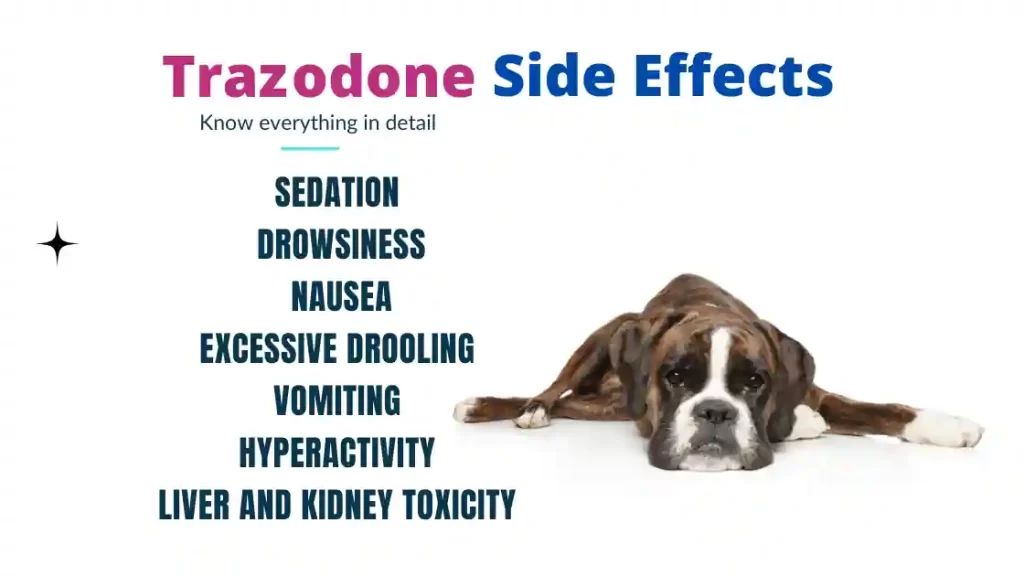What is trazodone?
Trazodone is an antidepressant medication that was originally developed for human use. It works by increasing the levels of serotonin in the brain, which can have a calming effect. Trazodone is sometimes prescribed by veterinarians for use in dogs, especially to treat anxiety and behavioral issues like separation anxiety, aggression, phobias, and more. Though not FDA approved for veterinary use, trazodone is commonly prescribed off-label by vets. It can be an effective medication when used appropriately under veterinary supervision.
According to the VCA Animal Hospitals, trazodone is chemically unrelated to other drug classes like benzodiazepines, so it has a different mechanism of action. But like benzodiazepines, it does appear to have anti-anxiety effects in animals. Trazodone takes around 1-2 hours to achieve peak effects, so it’s not used for acute behavioral issues requiring immediate sedation. But when given daily, it can help improve overall behavior and temperament issues in dogs.
How does trazodone work?
Trazodone is categorized as a serotonin antagonist and reuptake inhibitor (SARI) antidepressant. It works by blocking certain serotonin receptors and preventing the reuptake of serotonin, which increases the amount of serotonin available in the brain.
Specifically, trazodone is an antagonist at 5-HT2A, 5-HT2B, 5-HT2C serotonin receptors. This means it binds to these receptors and blocks them, preventing serotonin from binding. Trazodone also weakly blocks alpha-1 adrenergic receptors and histamine H1 receptors.
As an inhibitor of the serotonin transporter, trazodone prevents the reuptake of serotonin back into presynaptic neurons after it is released into the synapse. This increases serotonin levels in the brain. The combination of these mechanisms is thought to mediate trazodone’s therapeutic effects.
Compared to other antidepressants like SSRIs and SNRIs that solely prevent reuptake, trazodone’s dual action as an antagonist and inhibitor is unique. Its antagonism of certain serotonin receptors, particularly 5-HT2A, contributes to its sedative and anxiolytic effects.
Sources:
https://www.ncbi.nlm.nih.gov/books/NBK470560/
https://go.drugbank.com/drugs/DB00656
Trazodone uses in veterinary medicine
Trazodone is commonly prescribed by veterinarians to treat anxiety, behavioral issues, and insomnia in dogs. It is an antidepressant medication that has sedative and anxiolytic effects. Trazodone works by inhibiting the reuptake of the neurotransmitters serotonin and norepinephrine in the brain, which helps to boost mood and regulate behavior.

Trazodone is often used to help dogs that are suffering from separation anxiety, fear of noises, travel anxiety, aggression, obsessive behaviors, and more. By reducing anxiety and inducing sedation, trazodone allows dogs to relax and can curb problematic behaviors that stem from stress and anxiety. Trazodone takes effect relatively quickly compared to some other behavioral medications.
In addition to anxiety and behavioral disorders, veterinarians may prescribe trazodone to treat insomnia in dogs. Its sedative effect can help dogs fall asleep and stay asleep through the night. This can be very beneficial for dogs that have trouble sleeping or wake up frequently.
While trazodone is often effective for the conditions mentioned, it’s important to work closely with your veterinarian to determine if trazodone is appropriate for your individual dog. Your vet will take factors like age, other health conditions, and response to medication into account.
Trazodone as a dog sedative
While trazodone is often used to help induce sleep and sedation in dogs, it is not technically classified as a sedative. Trazodone is an antidepressant medication that has sedative side effects due to its serotonergic activity in the brain.
Trazodone can help calm anxious or stressed dogs and make them drowsy. It may be prescribed for dogs with anxiety, phobias, noise aversion, separation anxiety, aggression, obsessive compulsive disorders, and other behavioral issues. The sedative effects help dogs relax and sleep.
The sedation from trazodone usually sets in within 1-2 hours after administration. Effects can last up to 8 hours. Trazodone is commonly used short-term but may also be used long-term at lower dosages. It should be tapered off slowly and not stopped abruptly.
While trazodone can induce sleep in dogs, according to AKC, it does not induce the deep sleep needed for surgical procedures. Stronger sedatives are required for surgery. Additionally, some dogs may become more agitated with trazodone before calming down.
Overall, trazodone can have sedative effects in dogs but it is not technically a sedative medication. It is an antidepressant with sedation as a side effect. Veterinarians may prescribe trazodone to help anxious and stressed dogs relax and sleep.

Appropriate dosing of trazodone for dogs
The appropriate dosage of trazodone for dogs depends on the dog’s weight and the reason it is being used. Trazodone dosage should always be determined by a veterinarian, as dosing is tailored to the individual dog. Some general dosage guidelines include:
- For anxiety: Initial dose ranges from 1.7 to 9.5 mg/kg given by mouth every 8 to 24 hours.
- For sedation: Higher doses between 50 to 300 mg given by mouth are typically used.
- Small dogs less than 22 lbs (10 kg) may be prescribed 25 to 50 mg every 8 to 24 hours.
- Medium dogs 22 to 44 lbs (10 to 20 kg) may be prescribed 50 to 150 mg every 8 to 24 hours.
- Large dogs over 44 lbs (20 kg) may be prescribed up to 300 mg every 8 to 24 hours.
Veterinarians will start with lower doses and titrate up as needed. Doses, timing of administration, and length of treatment is tailored to the individual dog and situation (1). It is important to follow your veterinarian’s specific dosing instructions and monitor your dog closely when giving trazodone.
(1) https://bettervet.com/resources/pet-health-care/trazodone-for-dogs
Risks and side effects of trazodone
Like most medications, trazodone can have some side effects and risks when used in dogs. Some of the more common side effects can include:
Low blood pressure – Trazodone can potentially cause blood pressure to drop. This is seen more often when taking high doses of trazodone. Dogs may appear lethargic, weak, or uncoordinated if blood pressure drops too low.
Lethargy – One of the most frequently reported side effects of trazodone in dogs is sedation or lethargy. In studies, over 40% of dogs given trazodone experienced noticeable sedation. This is often desired when using trazodone for anxiety or as a sleep aid. However, lethargy can be problematic if severe or excessive.
GI issues – Vomiting, diarrhea, and other gastrointestinal effects have been reported in dogs on trazodone. Upset stomach is the most common complaint. Inflammation of the colon or colitis has also been seen in some cases. These side effects are usually mild but can lead to appetite loss.

Other less common side effects can include increased heart rate, dilated pupils, disorientation, weakness/ataxia, and allergic reactions in sensitive dogs. Most side effects are transient and resolve once the medication is stopped. However, veterinary guidance is recommended if any concerning or persistent effects are seen.
Citations:
https://www.dailypaws.com/dogs-puppies/health-care/dog-medications/trazodone-for-dogs
Monitoring Dogs on Trazodone
It is important to monitor your dog while they are taking trazodone to watch for potential side effects or adverse reactions. According to VCA Animal Hospitals, there is no specific monitoring that needs to be done while your pet is taking trazodone. However, it is still wise to keep an eye on your dog to ensure the medication is not causing excessive sedation or other problems.
Some signs to look out for when monitoring a dog on trazodone include:
- Excessive sedation or sleepiness
- Lack of coordination or balance issues
- Vomiting or diarrhea
- Changes in appetite
- Agitation or restlessness
If you notice any of these side effects, contact your veterinarian right away. It’s important not to adjust or stop trazodone dosage without the guidance of your vet. They may need to evaluate your dog and potentially adjust the dosage or frequency of trazodone administration.
According to the AKC, you should seek immediate veterinary care if your dog displays symptoms like muscle tremors, seizures, rapid heart rate, or collapses after taking trazodone. These could potentially indicate serotonin syndrome, a rare but serious reaction.
With proper monitoring and vet supervision, trazodone can be used safely in dogs. But being vigilant about side effects and staying in touch with your vet allows for the best outcome when using this medication for your pup.
Trazodone overdose and toxicity
Trazodone overdoses can be life threatening for dogs and require emergency vet care. Signs of a trazodone overdose include sedation, vomiting, diarrhea, weakness, low blood pressure, tremors, seizures, and coma. Studies have shown that trazodone overdose symptoms can occur in dogs at doses over 5 mg/kg.
If you suspect your dog has ingested an overdose of trazodone, contact your veterinarian or emergency vet clinic immediately. Treatment for trazodone overdose involves inducing vomiting if ingestion was recent, administering activated charcoal to absorb any remaining drug, intravenous fluids, and supportive care. The prognosis for trazodone overdose depends on the amount ingested and how quickly treatment is received.

Preventing access to medications is the best way to avoid trazodone toxicity in dogs. Keep all medications securely out of reach of pets. Never administer trazodone or any other medication to your dog without first consulting your veterinarian. Carefully follow prescribed dosing instructions.
Alternatives to trazodone
While trazodone can be an effective sedative for dogs, there are some alternatives that owners may want to consider. Here are some of the most common alternatives to trazodone for calming anxious dogs:
Other antianxiety medications: Veterinarians may prescribe other sedatives or anti-anxiety medications instead of trazodone based on the dog’s symptoms. Some common alternatives include fluoxetine (Prozac), benzodiazepines like alprazolam, and gabapentin. These medications work in different ways from trazodone but can also help relieve anxiety.
Natural calming remedies: Some owners want to try natural remedies to soothe anxious dogs before turning to prescription medication. Options include pheromone therapy with Adaptil or Feliway diffusers, calming treats with ingredients like melatonin or L-tryptophan, and supplements with chamomile, passionflower, or magnolia bark. While less potent than medication, these remedies may take the edge off milder cases of anxiety.
Training and behavior modification: Working with a veterinary behaviorist or certified trainer can help modify anxious behaviors in dogs through desensitization, counterconditioning, and positive reinforcement. While not a direct medication alternative, addressing the root cause of anxiety can reduce a dog’s need for trazodone or other drugs.
Environmental changes: Sometimes simple changes like establishing a predictable routine, providing a safe space or crate, diffusing calming scents like lavender, or using pheromone plug-ins can help lower an anxious dog’s stress. Reducing environmental stressors may decrease the need for medication.
Ultimately there are several effective options for calming anxious dogs beyond trazodone. It’s best to consult your veterinarian to determine which alternative is most suitable for your dog’s specific needs and anxiety triggers.
Summary
Trazodone is often used in veterinary medicine to treat anxiety-related conditions in dogs, including separation anxiety and fear-based aggression. While it can have a sedating effect, it is not technically considered a sleeping pill.
The sedative effects of trazodone usually occur within 1-2 hours of administration and can help dogs relax and feel less anxious. However, the actual mechanism by which trazodone relieves anxiety is not fully understood.
Trazodone is typically given at a starting dose of 3-5 mg/kg every 12-24 hours. Dosage can be adjusted based on the individual dog’s response. Overdoses can occur with high doses causing severe sedation, so it is important to follow veterinary guidance on appropriate use.
While trazodone may help induce sleep in anxious dogs, it does not induce the same deep sleep stages as true sleeping pills. Dogs given trazodone may still awaken to loud noises or stimuli. It should be used cautiously in dogs with pre-existing health conditions and can have side effects like lethargy and gastrointestinal upset.
In summary, while trazodone has sedative effects that can relieve anxiety in dogs, it is not technically a sleeping pill and does not put dogs into a deep anesthetic sleep. Dog owners should consult their veterinarian on proper dosing and supervision when using trazodone to treat canine anxiety issues.